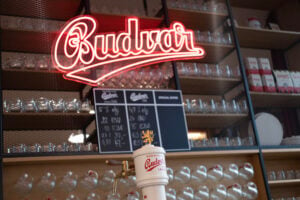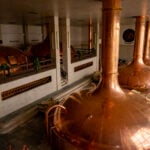A Journey Into Czech Lager with Budvar pt1
We’ve been trying to take our lager brewing up a notch recently, and what better way than to learn from some of the best in the world – Budvar!
A brief history of Pilsner
Lager is the most popular style of beer in the world – but just because it can be brewed on industrial scales doesn’t mean there aren’t plenty of smaller and independent breweries keeping traditional methods alive.
Pilsner can be seen as the archetype for lager as we now know it: the first ever pale lager was produced in the city of Plzeň in 1842 by Pilsner Urquell. A novel method of kilning allowed for a much paler malt than previously available, while large amounts of locally grown hops provided a crisper kick of bitterness and aroma than the Bavarian styles that were usually brewed.
The new Plzeň lager – Pilsner – became the dominant style in Bohemia, the area that is now the Czech Republic. Pilsner was soon being emulated across Europe, with distinct local variations in Germany, Belgium, and the Netherlands – including Heineken, the largest brewer in Europe.

Almost all modern pale lagers are derived from the original Pilsner template, and it’s not hard to see why. Approachable yet satisfying, crisp and refreshing, Pilsner appeals to both hardcore beer fans and casual drinkers.
Budějovický Budvar
To improve our lager brewing, we wanted to go back to the original Pilsner – so we jumped on a plane and headed to České Budějovice, home of the Budvar brewery.
Budvar has been been brewing since 1895 and produce their signature Budweiser Budvar Pilsner using time-tested methods and local ingredients. The brewery holds EU Protected Geographical Origin status and is owned by the Czech state to protect this. So they are very much keepers of the authentic, traditional style!
A note on naming
The city of České Budějovice is known as Budweis in German, so just as Frankfurters come from Frankfurt and Hamburgers come from Hamburg, beer from Budweis is Budweiser.
The American Bud was originally designed to imitate beers from Budweis, with the name chosen to show that. A huge trademark battle has been fought since the early 1900s with Budvar and AB-InBev (who make Bud) winning different rights to the Budweiser name in different areas.
Here in the UK neither company has exclusive rights, so if you want the authentic Czech beer, look for Budweiser Budvar!

Budvar brew 100% of the beer they sell at their own brewery, with no contract brews or outsourcing. The recipe for their Pilsner is deceptively simple: just one type of barley and one type of hops. But there’s a depth to the beer that reveals the precision and complexity that goes into it.
It begins with water from their own artesian wells on site. These draw from an Ice Age aquifer, giving incredibly soft and neutral water that Budvar do not alter or treat – beyond filtering out sediment, no chemicals or minerals are added. Their water is a super clean base for the other ingredients and vital to the final product. It’s so important that the Protected Geographical Indication status specifically calls out the water – Budvar can only ever use water from that one aquifer.
The malt is sourced from the Haná region of Moravia, in the southeast of the Czech Republic. Budvar use a heritage variety of barley that is then malted to their requirements. Likewise, they only use Saaz hops grown in Žatec in the Czech Republic – specifically, whole cones, never pellets or extracts.
Budvar’s house strain of yeast dates back to the founding of the brewery and is perfect for lager brewing. It’s adapted to the low mineral profile of the aquifer’s water and delivers beautifully crisp and balanced flavour.
A big small brewery
The scale of production at Budvar is mind-boggling, especially when you consider they’re only the fourth largest brewery in the country! They do ten brews per day, each producing 600 hectolitres. So that’s 600,000 litres every day! We used to think cleaning up after a 23 litre brew was tough…

The fermentation tanks each hold 2400 hectolitres, so it takes four brews to fill each of them. This blending of multiple worts promotes consistency, which is furthered when the beer is transferred to their lagering cellar.
When we say “cellar”, we mean four floors of giant 3700 hectolitre maturation tanks. These monsters are so big that they had to close the main road to bring them in!

Onto the packaging line, they process 50,000 bottles and 44,000 cans every hour. About half of the bottles are reused thanks to a country-wide returns scheme.
This really is a huge operation for an independent brewery – so you might be forgiven for thinking that means the beer is brewed with industrial methods, cheap and fast. And you couldn’t be more wrong… find out all about it in the second part of this blog!

Join us in the next part of this blog where we find out about Budvar’s processes, including the science of decoction and their special fermentation schedule.
The Czech say that a brewer brews, but the tapster “makes” the beer. In part three we discover the art of the perfect pour!
Then in part four we’ll cover how to make your best Pilsner at home – including how to adapt Budvar’s methods at homebrew scale.
Plus you can check out our four part video series with Budvar as we dig deep into the secrets of Czech lager! And remember to subscribe to our YouTube channel for all the latest brews and reviews from The Malt Miller.

